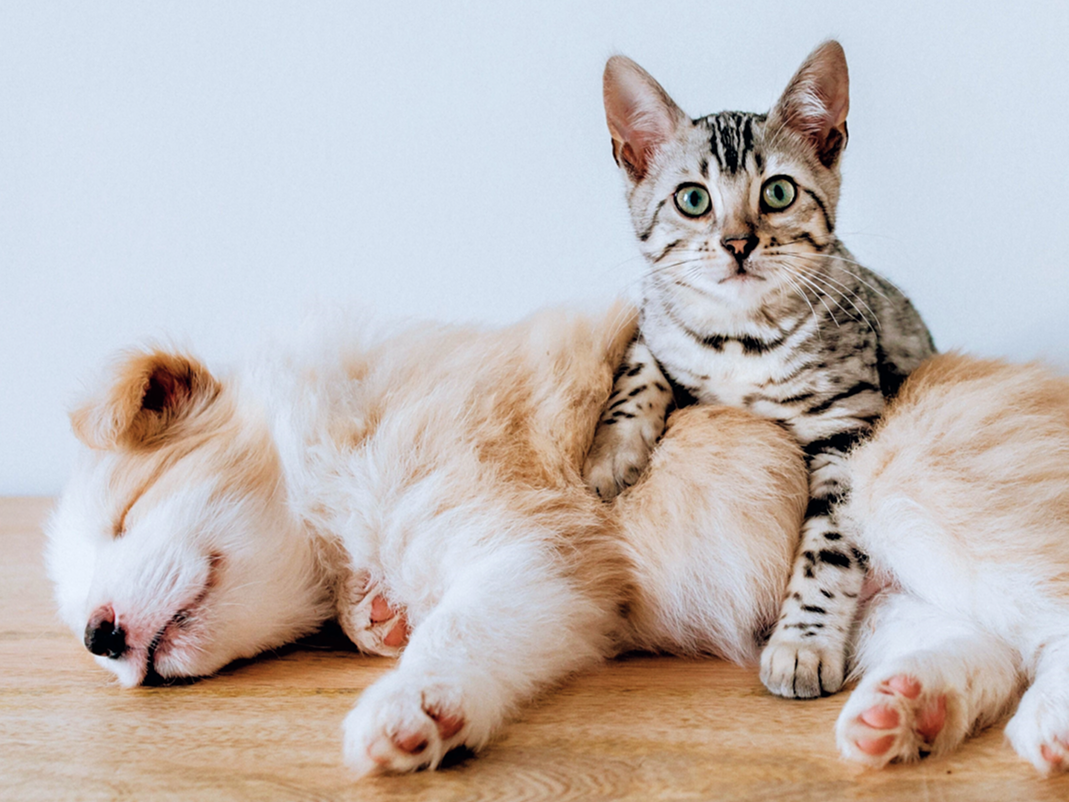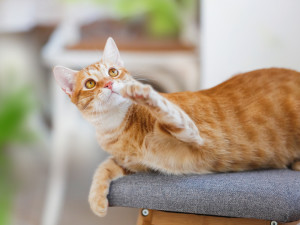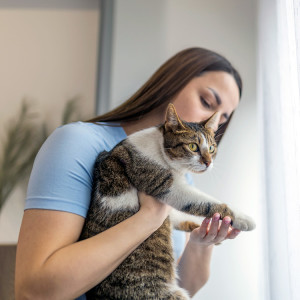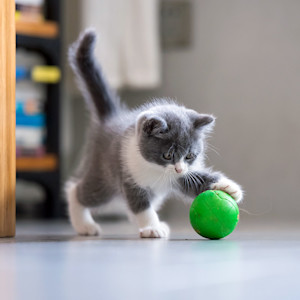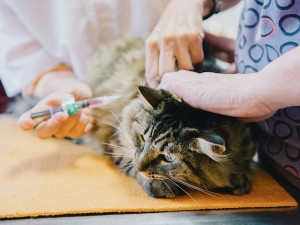What Is Pillow Foot in Cats?
And how you can protect their precious little toe beans.
In This Article:
What Is Pillow Foot in Cats? What Causes Pillow Foot in Cats? Pillow Foot Cats Symptoms How Is Pillow Foot In Cats Diagnosed? Pillow Paw in Cats Treatment
Paw pads are so precious that they frequently get special attention — just think of all the kittens named Mittens or the cat parents obsessed with “toe beans.” But what does it mean if a cat’s paw pads become swollen and painful? Swelling and bruising can be an indication of pododermatitis, or pillow foot.
Here’s what you need to know about pillow foot in cats.
Check out customizable policies from our friends at Lemonade Pet Insurance—so you only pay for what you need.
How much do you spend on your pet per year?
What is pillow foot in cats?
“My cat is a natural acrobat and will climb and jump from anything. Lately, he hasn’t been running or jumping as much; I think he may even be limping a little bit. When I looked at his paws, two of them were painful and mushy. My cat is FIV-positive, so I know that he’s more susceptible to infections, but this doesn’t look like an infection. What’s going on?”
This is a common story for cat parents before they find out that their cat has pododermatitis.
Plasma cell feline pododermatitis, or just feline pododermatitis, is a skin disease that affects a cat’s paw pads. The condition is commonly called “pillow foot” or “pillow paw” because it causes a cat’s paws to be swollen and “pillow-like.” Disease severity can vary, but many cats experience discomfort and skin lesions. Feline pododermatitis can occur in cats of all ages and breeds. It may be more common in male cats, but the evidence for this is poor. Fortunately, pillow foot is an uncommon condition in cats.
What causes pillow foot in cats?
We don’t completely understand why cat pillow foot occurs, but we do know that it’s the result of a high number of plasma cells — a type of white blood cell — infiltrating the paw pad tissue and causing swelling. Plasma cells typically create antibodies to help the body fight against infections, but in cases of pododermatitis, this influx of plasma cells can happen in the absence of infection. It’s thought to occur because of immune dysfunction.
Studies have suggested that cats who are immunocompromised have a higher risk of developing pododermatitis. It’s been reported that around 50 percent of cats diagnosed with pillow foot also had feline immunodeficiency virus (FIV), a virus that attacks the cat’s immune system. Allergies and external irritants may also play a role. Possible risk factors for pododermatitis in cats include:
Feline immunodeficiency virus (FIV)
Diabetes mellitus
Immunosuppression
Pillow foot in cats: Symptoms
The severity of symptoms in feline pododermatitis varies. Cats with mild symptoms may only experience a little soft swelling and visible discoloration of their paw pads, while cats with more severe disease can develop paw pad ulceration and bleeding.
Lesions include color changes, swelling, and breaks in the skin. Paw pads can develop white streaks, loss of pigment, redness, or bruising. The uncharacteristically soft paw pad swelling can be tender or non-painful. Changes in the paw pads can also progress to ulceration and open sores, providing opportunity for bacteria to cause secondary infections.
Cats with pillow foot develop lesions in the paw pads, claws, and the skin around the claws. Usually, more than one foot is affected. The metacarpal and metatarsal pads (the biggest paw pads) are most commonly involved, but the pads of the toes can be impacted too. For many cats with pillow foot, symptoms are isolated to their paws, but some cats experience so much discomfort that they become lethargic or anorexic. A small percentage of cats also develop inflammation on the bridge of their nose.
Symptoms of cat pillow foot include:
Puffy swelling of the paw pads
Pillowy-soft paw pads
Tenderness when paws are touched
Limping
White streaks on the paw pads
Paw pad bruising or purplish discoloration
Loss of pigment of the paw pads
Paw pad ulceration
Open sores on the paw pads
Bleeding from the paws
Swelling and irritation on the bridge of the nose
How is pillow foot in cats diagnosed?
A tentative diagnosis of feline pododermatitis can be made based on physical exam findings. If there’s any doubt, the best way to get a definitive diagnosis is to perform a biopsy and histopathology, which involves examining the tissue under a microscope. The tissue sample is sent to an independent laboratory for evaluation.
There are tests, like a fine-needle aspirate, that can be performed in-house to support the diagnosis. To perform a fine-needle aspirate, a needle is inserted into an affected paw pad so cells can be collected and examined under a microscope. Microscopic examination will reveal an abundance of plasma cells. If a paw pad is ulcerated, cells can be collected by simply pressing the damaged skin against a microscope slide. This surface sample may or may not show a high number of plasma cells, but it can reveal the presence of bacterial infection.
Pillow paw in cats: Treatment
For mild cases of pillow foot in cats, treatment may not be needed. Some cats have mild symptoms that come and go, or symptoms that simply resolve on their own. However, for many cats, treatment may be required. For some cats, managing pillow foot is a lifelong process due to recurring flare-ups.
Medication
Medication is the treatment of choice for pododermatitis in cats. Commonly used medications include:
Doxycycline: Doxycycline is often the first drug of choice for feline pododermatitis treatment. It’s an antibiotic that also affects the way the immune system behaves. Cats that are prescribed doxycycline typically stay on it until symptoms resolve, which often takes anywhere from ten to twelve weeks.
Steroids: Oral steroids like prednisolone can be prescribed to suppress the immune system and reduce inflammation.
Immune suppressing drugs: Cats can also be administered other immune-suppressing medications long term.
Medications for secondary infections: Sometimes specific antibiotics or anti-fungal medications are needed to address secondary infections.
Surgery
One of the main goals of treatment is to make a cat comfortable again, and if the lesions are so bad that relief can’t be achieved with medication, surgery may be performed to remove the ulcerated tissue. Surgery has been reported to be curative in some cats.
At-home care
There are no effective home remedies for pillow foot in cats, but there are things you can do to help keep your kitty comfortable:
Consider using softer or pelleted cat litter made of wood or recycled newspaper to avoid tiny bits of litter getting into ulcerated paw pads.
If your cat is prescribed doxycycline, follow the administration directions closely. Doxycycline can cause inflammation and stricture in the esophagus if it gets stuck on the way down, so it’s recommended that the medication always be followed up with food or water.
When to seek expert help
If you notice any changes to your cat’s paw pads or if walking seems painful for them, have them seen by a veterinarian. All paw pad changes aren’t necessarily due to pododermatitis, but your cat’s comfort (and their precious toe beans) should be a priority. Consult your vet if you notice:
Paw pad swelling
Painful paws
Cuts or ulcers on the paw pads
Bleeding from the paws
Concerning changes in your cat’s energy level or appetite
Bottom line
Feline pododermatitis is an immune-mediated disease that affects the paw pads of cats, often causing puffy swelling, color changes, and ulceration. Some cats only have mild symptoms while others develop severe, painful lesions. Because resolution takes time, early detection and treatment is important.
References
Brosseau, Gabrielle. “Feline plasma cell pododermatitis.” The Canadian veterinary journal = La revue veterinaire canadienne vol. 63,5 (2022): 545-548.
“Causes and Treatment of Feline Pododermatitis.” Royalcanin.com, 2016, academy.royalcanin.com/en/veterinary/feline-pododermatitisopens in new tab. Accessed 19 June 2025.
“Feline Plasma Cell Pododermatitis.” Veterinary Practice, Aug. 2014, www.veterinary-practice.com/article/feline-plasma-cell-pododermatitisopens in new tab.
Werner, Alexander, and Amanda Zetwo DVM. “Diagnosis & Treatment of Feline Plasma Cell Pododermatitis.” Cliniciansbrief.com, 28 Feb. 2023, www.cliniciansbrief.com/article/feline-plasma-cell-pododermatitisopens in new tab. Accessed 19 June 2025.

